Duncan Caldwell

Up-coming lectures, new articles & other additions:
If you’d like to watch videos of
- Nancy’s presentation on George Sand’s wampum bracelet & Sand’s trans-Atlantic connections,
- a concerto based on the discovery of ancient lithophones in New England,
- or my lectures
you can find many of them on my Vimeo channel.
In the meantime, please click on the little photos on the left to download these essays.
This is an essay about:
- the ways that archaeological observations were once hijacked and commercialized in the service of racism and colonialism,
-
-the drive that occasionally leads great researchers to jump to unjustified conclusions,
-
-and Jean-Loïc Le Quellec’s remarkable book The White Lady and Atlantis, Ophir and Great Zimbabwe: Investigation of an Archaeological Myth. Rock Art Research, 2019, Vol. 36, 2 (Nov.), pp 236-241.
This essay corresponds to the culminating lecture of a symposium entitled “Uses and Abuses of Thoreau at 200” held at the Department of Literature, History of Ideas, and Religion of the University of Gothenburg in Sweden on May 3rd & 4th, 2018.
This is the annex/sequel to “Mind Prints, Arrowheads, the Indians & Thoreau” (2018).
The following article appeared just in time for the 100th anniversary
of the end of the First World War.
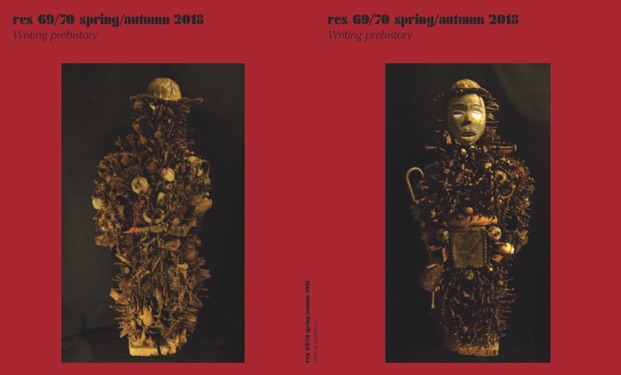
The Magic Trumpeter: A Bakongo Nkisi Nkondi and its links with World War I, the Harlem Hellfighters, and Jazz. RES: Anthropology and Aesthetics, RES 69-70, 2018 edition. University of Chicago & Peabody Museum of Archaeology and Ethnology & Art Museum, Harvard. University of Chicago Press. Inside & outside covers, explanatory cover page, and pp. 269-293.
After examining the history and practices surrounding the most impressive Bakongo statues pierced with metal, which are known as minkondi, this study analyzes the attachments and hidden structures of one modeled on a soldier. Several of the attachments, including apparent grenades, the regulatory knob from a German lantern used on the Western Front, and a trumpet sold by a New York company that supplied American military musicians during the First World War, were probably obtained in France, where Congolese soldiers fraternized with African-American troops in a sector with so many black soldiers that it was dubbed ‘L’Afrique’.
The article seizes the opportunity presented by the statue and its extraordinary assemblage to tell more about the hundreds of thousands of Africans who were thrown into battle and used in logistical capacities from France to Tanganyika, as well as the story of how those troops mixed with ones from the African diaspora, including musicians like Will Vodery, Tim Brynn, and James Reese Europe, who introduced jazz to Europe, and, by ricochet, back to white Americans. The consequences of those contacts in the midst of fighting in which black men were told to kill whites and exposed to unparalleled violence spawned civil rights and independence movements around the planet.
“The Magic Trumpeter” is beautifully illustrated, since all four of the journal’s color covers - front and back, inside and out - are devoted to its imagery.
Please click on the thumbnail photo on the left to download an integrated PDF of the cover illustrations, their captions, and the article.
***
of the torturous negotiations between Christopher Columbus and Queen Isabella I of Castile and King Ferdinand II of Aragon have kindly allowed me to share her chapter,
“Negotiating Troubled Waters. Christopher Columbus and the Catholic Monarchs (1485-1492),”
from the book Négociations d'hier, leçons pour aujourd'hui
(Negotiations of Yesterday, Lessons for Today) (Éditions Larcier, 2014)
on this website.
Please click on the possible portrait (at left) of Columbus
to read Nancy’s reconstruction of one of the most consequential negotiations in history.
***
The NPR station in Denver broadcast a story about Marilyn Martorano’s identification of prehistoric lithophones from Colorado on Sept. 16, 2018.
She was kind enough to write that my earlier work on New England’s lithophones
had served as her “bible”.
***
An article about the garden I built, which Nancy wanted so much to return to,
appeared in The Martha’s Vineyard Times on Sept. 12, 2018.
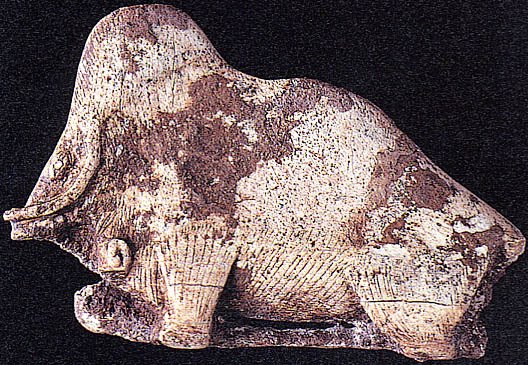
My discovery of optical illusions based on the similar contours of bison and mammoths is mentioned in a blog entitled “In Search of the World's Oldest Illusion:
Did Human Awareness of Illusions Arise with Self-Awareness?”
by Susana Martinez-Conde and Stephen L. Macknik
on the Scientific American website (June 29, 2018).
***
The Director of the Peabody Museum of Archaeology and Ethnology, Jeffrey Quilter, has an article called “The Grimaldi Figurine: A Return of Sorts” on pages 7 and 8 of the Fall 2016 issue of In Situ: News and Events of the Harvard Standing Committee on Archeology about my efforts to re-locate a Gravettian “venus” figurine, which I’d asked people at the museum to find in its reserves for a decade. Luckily, I was finally fortunate enough to catch his attention and persuade him of the importance of ensuring that the oldest undisputed image of a human being in an American institution was still under its care. To his credit, he put the full weight of his position behind the search for the statuette, which is known as the “Janus” or “Woman with the Perforated Throat”, and the hunt was ultimately successful.
***

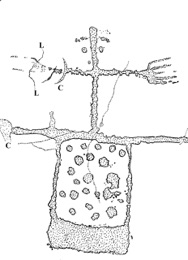

(Please click on the little photo to the left of the citation below each of the following blurbs
to download the relevant article.
If you’re looking for my show & lecture schedule,
please skip to the bottom of the page.)
The following three articles were published around the time Nancy was diagnosed with advanced ovarian cancer in 2015. We both had to turn away from doing much research afterwards, and focus instead on saving her.
-
1)The Implications of a New Corpus of Late Bronze Age Petroglyphs in the Forêt de Fontainebleau for Dating Local Rock Art. Rock Art Research (Vol. 32, No. 2: 178-192. Posted online by IFRAO 28 May 2015)
-
2)A New Typological Ordering of Adena Tablets Based on a Deeper Reading of the McKensie Tablet. RES: Anthropology and Aesthetics (RES 65/66, 2014/2015 joint edition: 105-127. Peabody Museum of Archaeology and Ethnology & Art Museum, Harvard University Press)
-
3)The Use of Animals in Birth Protection Rituals and Possible Uses of Stone Figurines from the Central Sahel. African Arts (Vol. 48, No. 4: 14-25. UCLA African Studies Center, MIT Press).
***
The first of these papers is about the discovery of the richest group of late Bronze Age petroglyphs in Europe. It shows how the engravings near Fontainebleau are closely related to pictogram vases from southern France while exhibiting more distant affinities with Neolithic artifacts from the Balkans. Some of the most complex motifs in the petroglyphs assemble smaller ones into the apparent equivalent of ideograms. In the process of exploring the relationships between such units and compounds, the article reveals links between an early swastika, crosses with dots between their branches, grids containing dots, "plowmen" in association with schematized cattle, and an owl-like figure with a punctuated grid and framed cross on its belly.
Finally, it shows how the petroglyphs overlap the most common rock art style in the Massif de Fontainebleau, which has often been described as Mesolithic (despite counter-indications). In doing so, it demonstrates that the so-called ‘classic’ style may be less than half as old as was thought, subverting a widely-held dogma of French prehistory.
***
You can download the second article, which was published by the Peabody Museum of Archaeology and Ethnology, by clicking on the next icon. The essay, which is called “A New Typological Ordering of Adena Tablets Based on a Deeper Reading of the McKensie Tablet”, was sparked by a cascade of recognitions that show how the enigmatic tablets might have been related to each other. It also provides a case study in how imagery can grow so allusive that it can embody, encrypt, and sustain a complex ideology—in this case, the one that set the template for Woodland beliefs in the middle Ohio Valley until contact with Europeans.
***
The third article, which was published by African Arts, describes unknown rituals and misidentified statuettes from the central Sahel. After dividing the figurines of women and animals, which had been ascribed to the Neolithic and the Sahara despite a dearth of evidence, into families, the paper shows that the best documented sculptures in the first two can be tracked to Burkina Faso (rather than the Sahara), while the third and fourth families probably come from Mali and Niger. Although the last one might be Neolithic, the other three, which overlap stylistically, were probably made during the historic era, since they include sculptures of dromedaries, which only arrived in the zone around 2000 years ago.
The investigation also uncovered birth protection rituals involving both live animals and anthropomorphic figurines made of animal bones. The revelation of such customs by traditional midwives and fertility practitioners opens new avenues for research throughout Africa while casting possible light on the stone figurines, whose four families appear to come from different places than the one they were associated with (the Azawagh), while three also seem to be younger than hoped.
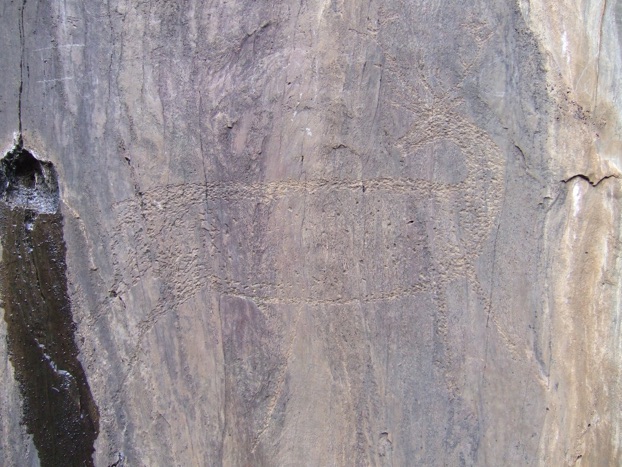
A petroglyph of a stag turning its head
Vale de Cabroes, Foz Coa, Portugal

Nancy in bed with bronchitis and a bottle of cider. By Duncan Caldwell. 1977.
More news & additions:
After learning of my American Antiquity article identifying stone rods from ancient New England as probable lithophones, the conductor of the Boston Landmarks Orchestra, Christopher Wilkins, asked Donald Krishnaswami to compose a concerto to celebrate the soundscapes experienced by their makers as they played the instruments, felled trees, carved sea-worthy canoes and even hunted swordfish. The ensemble played the world premiere of Don’s work, “The Swordfishers - Tone Poem for Lithophones, Slit Drums and Orchestra”, at the Hatch Shell in Boston on Aug. 19, 2015. Please click on these links to see the program notes (pp. 8-10), which I wrote with Don, an article by Don in The Juilliard Journal called “Composing for Log Drums and Orchestra”, and reviews of his powerful new composition in the Boston Globe and Boston Classical Review.
Please click here to see the public rehearsal from the vantage point of the orchestra
& here to see the first uninterrupted performance from the perspective of the audience .
***
My most ambitious article, “Hair Distribution, Immuno-resistance and Adaptations to the First Baby Slings”, which appeared in Anthropologie - International Journal of Human Diversity and Evolution (2013, Vol. 51, No. 3: 349-374), can be downloaded by clicking on the next photo. The essay postulates that infectious and parasitic conditions in the first baby-carrying devices selected for changes in juvenile hair distribution and immuno-resistance by killing previously well-adapted infants, and triggered a cascading founder’s effect that largely explains the speciation which gave rise to the first human species. The article also explores the evidence for a related hypothesis, which suggests that the first baby slings gradually forced our ancestors to focus more on acquiring the specific nutrients that newborns with relatively immature brains needed for their brains to mature later than before, because the devices both eliminated the need for babies to be born with brains that had developed enough to give them strong clinging reflexes and quick mobility, and allowed (or even fostered) babies with more slowly maturing brains to survive. The dietary consequences of this shift towards altriciality and postnatal brain development could have triggered more scavenging, hunting, and feedback mechanisms that slowly extended the new juvenile hair distribution to adults as part of a whole-body cooling system based on sweat and body baldness while contributing to the evolution of the next species in our lineage.
***
The following articles about a newly discovered frieze, which includes an early Neolithic, Bégude-type prestige axe from the Italian Alps, a huge anthropomorph coifed with ten “plumes”, and two apparent boats, appeared in June 2014 - the first in Antiquity, and the second, by our same team, in Art Rupestre. The larger “vessel”, which has high angular extremities and a hook that looks like a steering oar or bird’s beak, appears to illustrate a complex watercraft made of planks, rather than the kind of simple dug-out canoes that have usually been associated with the western European Neolithic. The likelihood that the motif illustrates a boat like a Haida war canoe fundamentally changes our conception of what Europe’s early Neolithic people could do and build, making it much more likely, for example, that they engaged in extensive trade and even whaling.
***
A controversial article called “An historic sign, possible Mesolithic menhir, DStretch, and problems in dating rock art to the Sauveterrian in the Massif de Fontainebleau”, which appeared in the Journal of Archaeological Science in February 2014 (JAS, vol. 42: 140-151), can be downloaded by clicking on the next icon. The paper eliminates the only chronological marker for dating the largest concentration of supposed Mesolithic rock art in Europe – the “classic” schematic engravings in the Massif de Fontainebleau – by showing that part of an incised and painted boulder, which was thought to have lain undisturbed for over 7,000 years, actually bears medieval vulvas and historic letters. But it goes on to find a silver lining by demonstrating that the monolith could be the oldest known menhir in France, which suggests that western European megalithism might have begun in the Massif, before spreading to such places as Brittany, Portugal, and the British Isles.
***
An article by Jacques Daniel, which alludes to some prehistorians’ efforts to brush aside the conclusions of the above JAS article, appeared in Archéologia in March 2014 under the title “Fontainebleau - Le menhir de la discorde”. Despite the fact that the report, which can be downloaded by clicking on the following icon, contains minor inaccuracies, its gist is correct.
***
Here’s an article about nearly identical artifacts from the eastern and western ends of the Sahara. The paper, which is called “Western Saharan Sculptural Families and the Possible Origins of the Osiris-Horus Cycle”, identifies two sets of Neolithic symbols, which seem so similar, despite being separated by the entire length of the desert, that the similarities might indicate a link. It determines that the sets’ ages seem to overlap at the beginning of the 4th millennium BC and weighs the probability of a westward versus an eastward transfer around that time. Finally, it shows that one explanation for the similarities might be the arrival in the Nile Valley of refugees who fled the rapid desertification of the period by retracing the steps of pastoral ancestors. If this scenario is correct, some of the elements of Egyptian theology that became the prerogatives of royalty and rationale for kingship, including the Horus-Osiris cycle, arrived from the west as the result of a primordial exodus caused by climate change.
***
This article argues that a previously unrecognized class of prehistoric musical instruments existed in the Americas in the form of highly sculpted stone rods, which were used as lithophones in New England during funerals around 8,000 years ago (the early Archaic Period).
***
The next article is about a huge Neolithic face surmounted by five plumes that I found in Nanteau-sur-Essonne before the discovery of the even more spectacular anthropomorph with ten plumes in Buthiers. In an effort to date the stela, the richly illustrated paper examines its relationship with similar monuments from the Channel Islands to Switzerland, and shows why it is probably one of the oldest of them all.
NOTE: The PDF of this article, which I received from the journal’s editor, Laurent Valois, before it went to press, differs from the printed version, because the person in charge of taking the files to the printer ignored the editor’s instructions and gave the printer an inaccurate partial translation, which had not been validated. The only official and approved version of this article is therefore this PDF. The editor has promised to publish an erratum concerning the printed version, which neither of us approved, in the next issue of Art Rupestre.
***
A eulogy for P.G. Harris and call-to-arms to save one of the earliest post-contact portrayals of life in New England by American Indians.
From The Martha’s Vineyard Times (Oct. 24, 2012) & Vineyard Gazette (Oct. 25, 2012).
***
The Woods Hole Oceanographic Institute announced my discovery of a possible new class of prehistoric musical instruments in northeastern North America - portable cylindrical lithophones - in its journal Oceanus (Vol. 49, 2:53) and as its “Image of the Day” for Aug. 15, 2012.
***
Nancy’s story on her experiences in Rwanda, “Listening to the Kigali Night”, is in the March 23, 2012 edition of the International Herald Tribune & the New York Times website.
***
A summary of a presentation in the California Academy of Sciences' Planetarium (8 Sept. 2011) on King Tutankhamun's Libyan Desert Glass scarab and the expedition that solved the enigma of how the ancient Egyptians got the material to make it, when they couldn’t reach the glass’s natural source even if they had camels. Which they didn’t. All they had was donkeys.
***
National Geographic’s report on the discovery of one of the world’s oldest known true optical illusions with further comments.
***
The story of how an excursion to Neolithic monuments went awry when we stumbled on a murder and bombing.
***
Some Scheduled Events:
April 27-29, 2022
The Magic Trumpeter -
An exceptional BaKongo statue
& its links with Jazz & World War I
Princeton University at the invitation of Chika Okeke-Agulu, MFA, PhD; Director, Program in African Studies, Professor of African Art & African Diaspora Art, Department of Art & Archaeology, Department of African American Studies
April 9-16, 2022
Cave tour in the Dordogne
for a group of 30, consisting of the CEOs and families of employees of the Swedish firms, Hot Disk AB & Kagaku Analys AB.
Autumn 2020
&
The Magic Trumpeter -
An exceptional BaKongo statue
& its links with Jazz & World War I
The first Zoom lecture, which is about Thoreau’s evolving relationship with Native Americans and their artifacts, can be seen by clicking here.
The one about the BaKongo statue and the Harlem Hellfighters
can be seen by clicking here.
Mariposa Museum,
Peterborough, NH & Oak Bluffs, MA
Oct. 22, 2020
An Archeological Journey around Jordan
Zoom lecture 6 PM EST
This lecture can be viewed either on my Vimeo channel by clicking here
or the Vineyard Haven Library’s channel
by clicking here.
Vineyard Haven Public Library
Vineyard Haven, Massachusetts
Aug. 8, 2020
(This replaces the Aug. 19th in-person talk due to the pandemic)
Zoom lecture 4 PM
Chilmark Public Library, Chilmark, MA
July 4th to Sept. 30th, 2020
(Exhibition Guest Curator, Duncan Caldwell)
Click on the
The Magic Trumpeter nkisi nkondi
and the
American figurehead of an African king
to read about
the Bakongo statue with links to WWI & the Harlem Hellfighters
and the monumental bust at the
Mariposa Museum & World Culture Center
57 Circuit Avenue, Oak Bluffs, MA 02557
Open daily from 9 a.m. to 6 p.m.
and 9 p.m. Saturdays.
Tel. 603-400-5440
info@mariposamuseum.org
June 27, 2020
Artifact ID Day
Cancelled due to the pandemic
with James Richardson, Jill Bouck, Bill Moody, Richard Burt & Fred Hotchkiss
1 - 3:30 PM - West Tisbury Public Library
West Tisbury, Massachusetts
Jan. 16, 2020
Jan. 31, 2019,
Jan. 31, 2018 & Jan. 16, 2017
Réétudier les collections muséales de Préhistoire : pourquoi ?
9:15 - 10:45 AM,
Musée de l’Homme, 17 Place du Trocadéro, 75016 Paris, France.
Module d’Ecole Doctorale,
Muséum National d’Histoire Naturelle (MNHN), Spécialité “Quaternaire et Préhistoire : Paléoenvironnements, lignée humaine, histoire des sociétes”,
Unité de recherche: UMR-CNRS 7194, Département: Préhistoire MNHN, Information: Bureau 321.
May 4, 2018
This was the culminating lecture
of an international symposium called
“Uses and Abuses of Thoreau at 200”
at the Dept. of Literature, History of Ideas, and Religion.
May 3-4, 2018.
University of Gothenburg, Sweden
August 5, 2016
The Magic Trumpeter -
An exceptional BaKongo statue
& its links with Jazz & World War I
3 - 5 PM (two full hours)
(Following presentations by art historian Cheryl Finley, food historian Jessica Harris, and dancer Reggie Wilson)
Oak Bluffs Public Library
during the Oak Bluffs African-American Literature & Culture Festival
If you’d like to read an article (with a few simplifications & mistakes) about the talk, please follow this link to the Vineyard Gazette.
All of August 2016
(Opening reception 6 - 8 PM,
Aug. 4, 2016)
Ted Joan’s Collages -
Dr. Rotapep’s Teducation
in life, poetry & totem animals
(Rhino-okapi-tapir-aardvark-pangolin-echidna-platypus)
(Curated by Duncan Caldwell)
Oak Bluffs Public Library
in the context of the Oak Bluffs African-American Literature & Culture Festival
(This is a homage to Ted, who had a meal a day with us, whenever he was in Paris, for 17 years.)
All of July 2016
(Reception 6-8 PM, Friday, July 8th)
Susanna & Duncan Caldwell’s Art
(A brother & sister show)
Oak Bluffs Public Library
July 28, 2016
The Magic Trumpeter -
An exceptional BaKongo statue
& its links with Jazz & World War I
You can either see this in one piece on my Vimeo channel or in two parts by going to MVTV and searching for “Duncan Caldwell”.
5 - 7 PM, Old Town Hall for the Aquinnah Public Library, Aquinnah, Massachusetts
July 21, 2016
George Sand & the Quahog Necklace
(Nancy’s presentation on George Sand’s unknown links to New England)
You can see either see Nancy’s presentation on my Vimeo channel or by going to MVTV and searching for “Nancy Caldwell”.
5 - 6:30 PM, Old Town Hall for the
Aquinnah Public Library, Aquinnah, MA
April 19, 2016
Un trompettiste magicien :
Une mystérieuse statue
Kongo et ses liens avec la 1ère guerre mondiale
(in French with English slides)
2h00-4h00 PM, Détours des Mondes,
EPSS, 139 Bd. du Montparnasse, Paris
Jan. 18, 2016 & Feb. 19, 2015
Réétudier les collections muséales de Préhistoire : pourquoi ?
10 - 11:30 AM, Musée de l’Homme, Salle Leroi Gourhan, 17 Place du Trocadéro, 75016 Paris.
Module d’Ecole Doctorale,
Muséum National d’Histoire Naturelle,
Département “Homme, Nature, Société”.
Aug. 14, 2014
Prehistoric Rock Art near Paris - Glories, New Discoveries & Controversies
5 - 6:30 PM, Old Town Hall for the Aquinnah Public Library, Aquinnah, Massachusetts
April 17, 2014
Re-examining Museum Prehistory Collections in Search of Fresh Perspectives
Muséum National d’Histoire Naturelle,
Département “Homme, Nature, Société”,
3:30 - 5 PM, Amphitheater, 57, rue Cuvier, Jardin des Plantes; 75005 Paris, France.
January 30, 2014
La datation des pétroglyphes de la forêt de Fontainebleau / The ‘Prehistoric’ Petroglyphs of the Massif de Fontainebleau & their Dating
SAGA (Société Amicale des Géologues Amateurs)
6:30 - 7:30 PM, Bâtiment de géologie,
Muséum national d'Histoire naturelle.
43 rue Buffon, Paris, France. (In French)
Dec. 12, 2013
Designing Time Machines:
Reflections on the creation of archaeology & ethnology museums.
Ecole Nationale Supérieure d'Architecture (Nantes) doctoral program. (In English)
Oct. 3, 2013
Decoding the Adena Tablets:
New Interpretations of the "Mound Builder" Tablets
University Seminar on the Arts of Africa, Oceania, and the Americas
7 - 8:30 PM, Schermerhorn, room 930,
Columbia University (Main campus), NYC
Aug. 20, 2013
Decoding the Adena Tablets: A Great Civilization and its Mirrors
7 - 8:30 PM - Vineyard Haven Public Library
Vineyard Haven, Massachusetts
Aug. 8, 2013
The Birth of Our Genus: The tool that changed us from head to foot
5 - 6:30 PM - Aquinnah Public Library
Aquinnah, Massachusetts
July 27, 2013
Digging into Deep Time
For children (of all ages)
2 - 3 PM - Aquinnah Public Library
Aquinnah, Massachusetts
May 31, 2013
2 Presentations:
Recent megalithic discoveries
in the Massif de Fontainebleau
8:00 - 8:30 AM &
The Saharan Origins of Ancient Egyptian Royal Symbols
8:30 - 9:30 AM,
International Rock Art Congress
International Federation of Rock Art Organizations (IFRAO) & American Rock Art Research Association (ARARA)
Albuquerque, New Mexico
May 20, 2013
The Saharan Origins of Ancient Egyptian Royal Symbols
7:00 - 8:30 PM
46 East 70th Street, NYC, NY
(Tickets on sale from 6PM / Reservations (212) 628-8383).
May 11, 2013
Western Saharan Sculptural Families and the Possible Origins of the Osiris-Horus Cycle
Musée National de Préhistoire
Les Eyzies-de-Tayac, Dordogne
3h00 - 3h30 PM, Assemblée générale de l'Association Lithos (In French)
May 3, 2013
Réétudier les collections muséales de préhistoire : pourquoi ?
Module d’Ecole Doctorale,
Muséum National d’Histoire Naturelle.
Institut de Paléontologie Humaine (I.P.H.) 3h30 - 5h00 Amphitheater
1 Rue René Panhard; 75013 Paris, France.
Aug. 28, 2012
The Saharan Origins of Ancient Egyptian Royal Symbols
7:00 PM, Vineyard Haven Public Library,
Vineyard Haven, Massachusetts
Aug. 7, 2012
The Place of Testing: The Epic Expedition that Solved the Last Mystery of King Tut's Tomb.
5:30 PM, Edgartown, Massachusetts
July 24, 2012
The Saharan Origins of Ancient Egyptian Royal Symbols
5:00 PM, Aquinnah Public Library,
Aquinnah, Massachusetts
May 30, 2012
Re-examining Museum Prehistory Collections in Search of Fresh Perspectives
Module d’Ecole Doctorale,
Muséum National d’Histoire Naturelle.
Institut de Paléontologie Humaine
11 - 12h30, Amphitheater
1 Rue René Panhard; 75013 Paris, France.
Sept. 8, 2011
Voyage to the Sun: How the Egyptians Retrieved Solid Sunlight for Tutankhamun’s Tomb
Special event, Planetarium, 6:30 PM
California Academy of Sciences,
San Francisco, California.
Sept. 6, 2011:
The Mirage of Simplicity
in Paleolithic Art
San José State University (SJSU) Graduate School of Art + Design
San José, California.
Aug. 11, 2011:
Correcting Neanderthal Reconstructions
Aquinnah Public Library, Massachusetts.

My passions range from my family, writing, painting, photography and prehistory to the designing of integrated complexes of gardens and buildings. This website contains descriptions of - or links to - my work in each of the following fields:
- peer-reviewed scientific papers,
- renderings and photos of building projects,
- novels, screenplays, and poetry
- short works of non-fiction, including Part I of my father’s biography, and
- paintings & photo galleries.
The site also contains information on:
- archaeological tours and lectures
- pictures of little-known works of prehistoric art, and
- videos, a blog, and more.
Albums & Manuscripts
Please click on the following thumbnail photos, which I’ve used as icons, to see the web pages or PDFs described in the captions.
The Foz Coa / Coa Valley Paleolithic art scandal
Travel Photos
Rock Art Photos
Expedition Photos
Saving the Gay Head Lighthouse
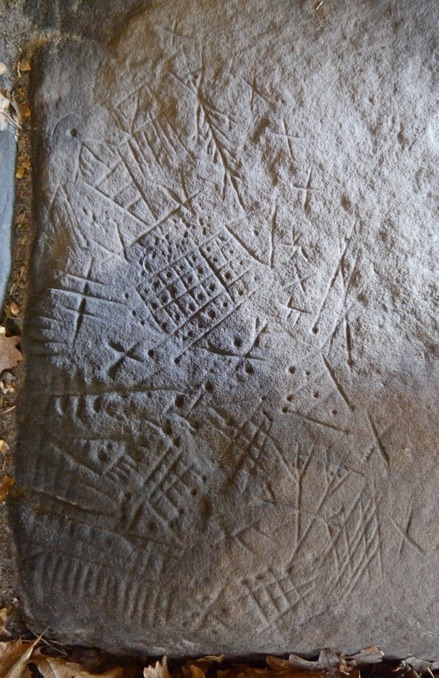
Vente Bourbon 1, Foret de Fontainebleau, Seine-et-Marne. I found this late Bronze Age engraving while prospecting with my friend Richard Lebon on April 22, 2015.
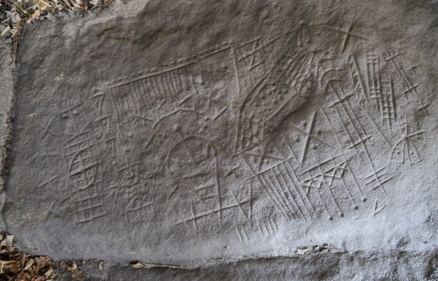
Vente Bourbon 2, Foret de Fontainebleau, Seine-et-Marne. My friend, Richard, found this equally beautiful late Bronze Age engraving later in the day.
Deer under a scene which might show people throwing two “falling” figures off the cliff above the cave, or else a dance around the figures, who might be lying on their bellies, in a trance.
Grotta dell’Addaura 1, Palermo, Sicily.
Late Magdalenian.
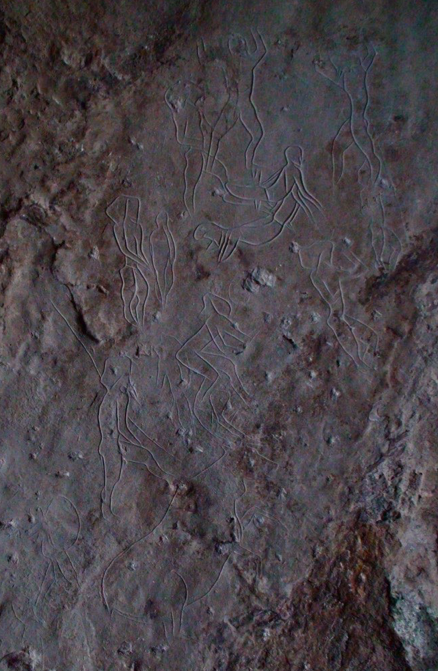
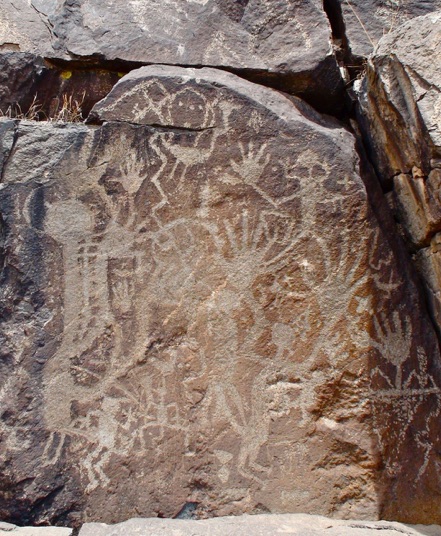
The fingers on the huge hands of the figures in this petroglyph often lead to other figures.
Galisteo Dike, Lamy, New Mexico

Enjoy your visit!
© 1977 to 2022, Duncan Caldwell
Key words: The Neanderthal insulation hypothesis; Baby sling adaptations; The baby-sling hypothesis for human body baldness, Paleolithic venus / venuses; The “prey-mother” hypothesis - A new interpretation of Paleolithic feminine imagery; Biography of Robert Granville Caldwell, Jr.; Leon Liebgold; General Patton; Landsberg Concentration Camp Complex; Archaeological & prehistoric art cave tours; Testimonials; Prehistoric phalangeal figurines; Pascal Raux - Father of the phalangeal figurine hypothesis; Duncan Caldwell’s paintings; Alan Dershowitz; Dan Burstein, Secrets of the Code; Marine and Paleobiological Research Institute ( MPRI ); New Dominion Pictures; GREPAL; Gaumont; Wellspring Museum; Neanderthal / Neandertal adaptations and extinction; Architecture & landscape design; Balkan prehistory; Vinca, Lepenski Vir; Martha’s Vineyard Community Services Possible Dreams auction; Robert Bednarik; Rock Art Research; Susiluola (Wolf) Cave, Lappfjärd, Finland; paleontology museum in Paris / Montmartre quarries; Biography of Robert Caldwell; Paleolithic cave art; Paleolithic art; Foz Coa; Coa Valley rock art; Korean prehistory; Bangudae Petroglyphs, Daegok-ri, Ulsan, South Korea; Neanderthal behavior; Neanderthal diet; King Tut’s desert glass scarab; California Academy of Science’s Planetarium revelations about Tutankhamun’s Libyan Desert Glass scarab;
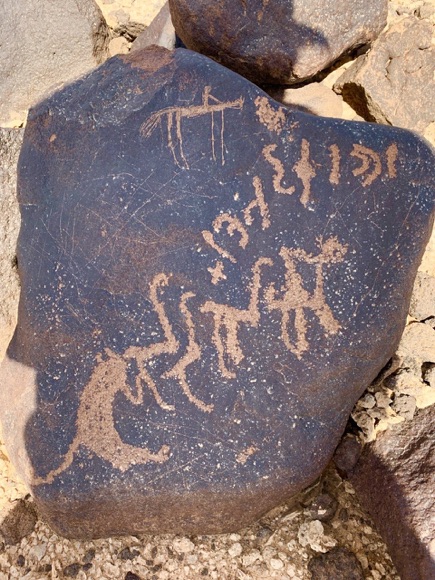
Safaitic petroglyph near Maitland’s Mesa, Jordan.
One of more than 30 petroglyphs around a tumulus. A feline is following ostriches & a man on a horse or camel, with a filliform horse & rider above them.

























